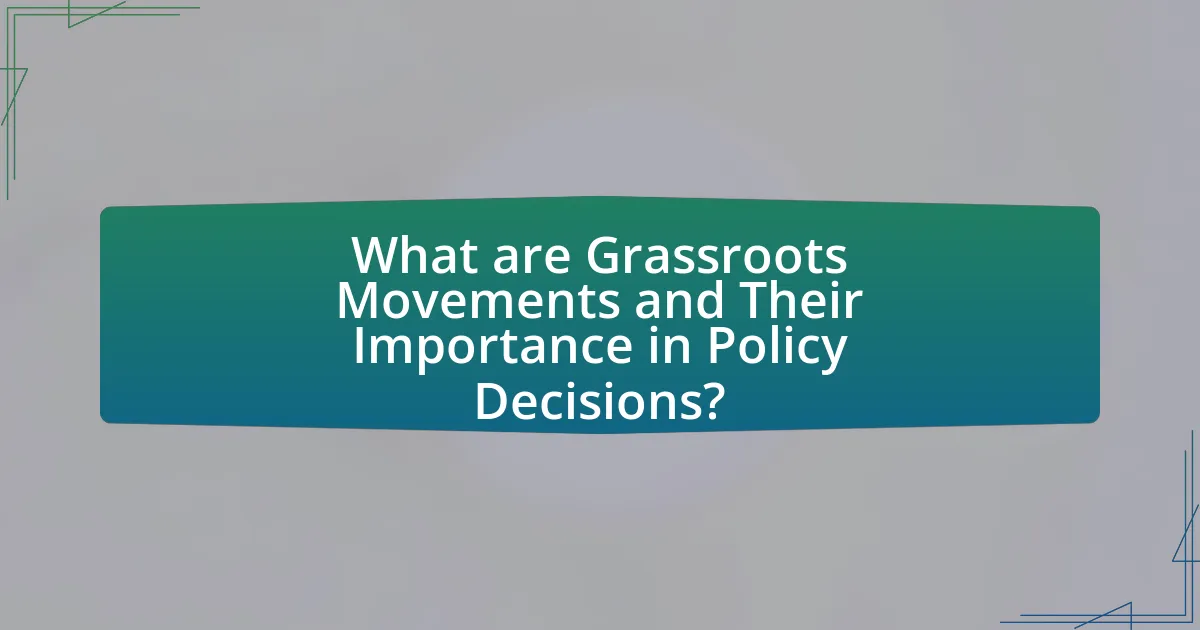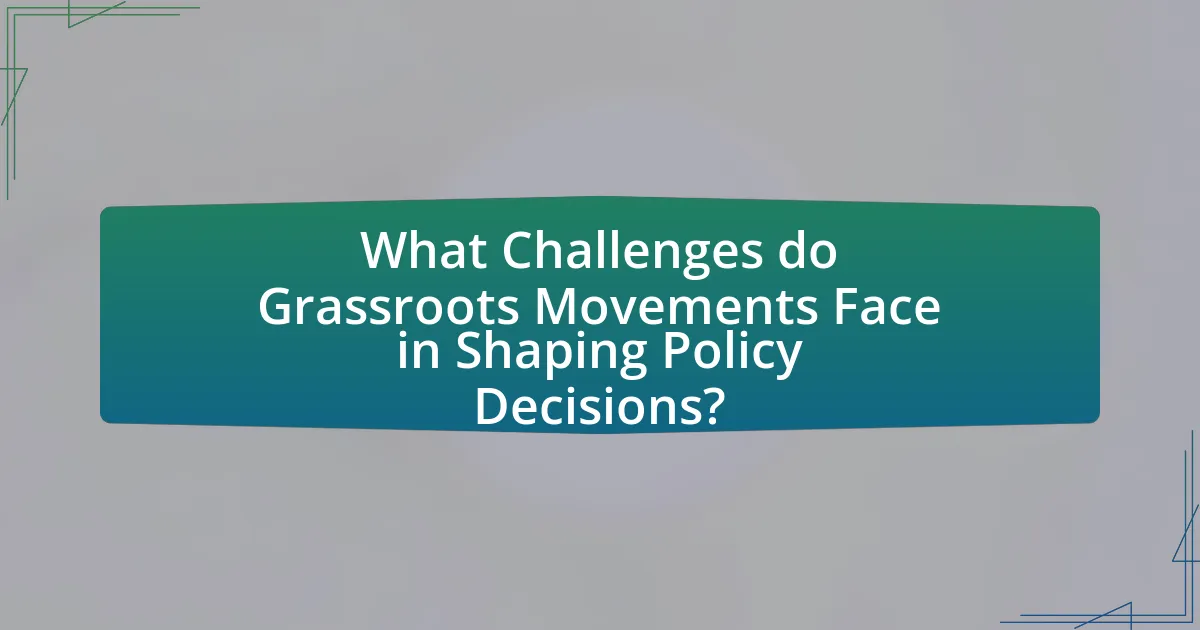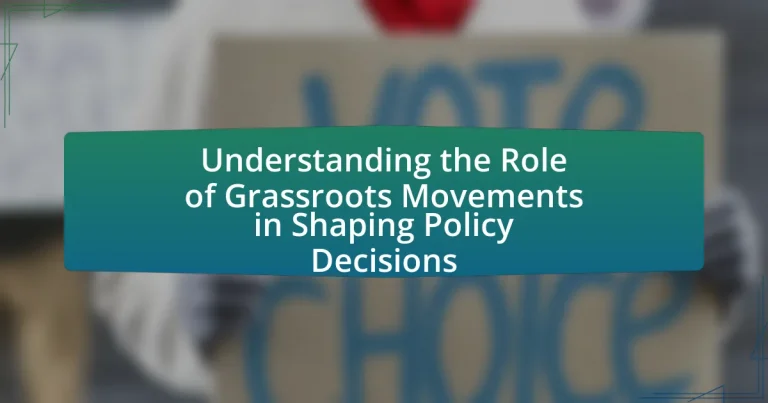Grassroots movements are organized efforts by ordinary individuals at the community level aimed at advocating for social, political, or environmental change. These movements play a critical role in shaping policy decisions by mobilizing public opinion, raising awareness, and influencing lawmakers through collective action. The article explores how grassroots movements impact political processes, engage local communities, and amplify marginalized voices, while also examining the strategies they employ to mobilize support and the challenges they face in advocacy efforts. Key characteristics of successful grassroots movements, the importance of leadership, and the role of social media in modern activism are also discussed, providing a comprehensive understanding of their significance in democratic participation and policy reform.

What are Grassroots Movements and Their Importance in Policy Decisions?
Grassroots movements are organized efforts by ordinary people at the community level to advocate for social, political, or environmental change. These movements are crucial in policy decisions as they mobilize public opinion, raise awareness about specific issues, and influence lawmakers by demonstrating widespread support or opposition. For instance, the Civil Rights Movement in the United States effectively changed legislation by mobilizing grassroots support, leading to the Civil Rights Act of 1964. This illustrates how grassroots movements can directly impact policy by creating pressure on decision-makers to respond to the demands of the community.
How do Grassroots Movements influence political processes?
Grassroots movements influence political processes by mobilizing community members to advocate for specific policy changes and social justice issues. These movements often raise awareness about local concerns, engage citizens in political discourse, and apply pressure on policymakers through protests, petitions, and lobbying efforts. For example, the Civil Rights Movement in the United States effectively utilized grassroots organizing to challenge segregation laws, leading to significant legislative changes such as the Civil Rights Act of 1964. Additionally, grassroots movements can shift public opinion, as seen with the environmental movement, which has successfully brought climate change to the forefront of political agendas, influencing legislation like the Paris Agreement.
What strategies do Grassroots Movements use to mobilize support?
Grassroots movements mobilize support through community engagement, social media campaigns, and coalition-building. Community engagement involves organizing local events, town halls, and workshops to educate and involve citizens directly, fostering a sense of ownership and urgency around issues. Social media campaigns leverage platforms like Twitter and Facebook to spread awareness, share stories, and rally supporters quickly, as evidenced by movements like Black Lives Matter, which gained traction through viral hashtags and online activism. Coalition-building brings together diverse groups and organizations to amplify voices and resources, enhancing the movement’s reach and impact, as seen in the Women’s March, which united various feminist and social justice organizations to advocate for women’s rights.
How do Grassroots Movements engage with local communities?
Grassroots movements engage with local communities by fostering direct participation and collaboration in social and political issues. These movements often organize community meetings, workshops, and events to raise awareness and encourage dialogue among residents, thereby building a sense of collective identity and purpose. For example, the Black Lives Matter movement has effectively mobilized local communities through protests and educational initiatives, highlighting systemic racism and advocating for policy changes. This engagement is further supported by the use of social media platforms, which facilitate communication and organization, allowing grassroots movements to reach a wider audience and amplify their message.
Why are Grassroots Movements essential for democratic participation?
Grassroots movements are essential for democratic participation because they empower individuals and communities to influence political processes and advocate for their rights. These movements mobilize citizens at the local level, fostering engagement and ensuring that diverse voices are heard in decision-making. For instance, the Civil Rights Movement in the United States demonstrated how grassroots activism can lead to significant legislative changes, such as the Voting Rights Act of 1965, which aimed to eliminate racial discrimination in voting. This historical example illustrates that grassroots movements not only raise awareness about social issues but also drive policy reforms that reflect the will of the people, thereby strengthening democracy.
What role do Grassroots Movements play in amplifying marginalized voices?
Grassroots movements play a crucial role in amplifying marginalized voices by providing a platform for underrepresented communities to express their concerns and advocate for their rights. These movements mobilize individuals at the local level, fostering community engagement and collective action, which can lead to increased visibility of issues faced by marginalized groups. For instance, the Black Lives Matter movement has effectively highlighted systemic racism and police brutality, influencing public discourse and policy changes. Research indicates that grassroots activism can lead to significant shifts in policy, as seen in the successful campaigns for social justice and environmental reforms, demonstrating the power of collective voices in shaping societal norms and legislative outcomes.
How do Grassroots Movements contribute to civic engagement?
Grassroots movements significantly enhance civic engagement by mobilizing individuals at the community level to participate in political processes. These movements empower citizens to voice their concerns, advocate for change, and influence policy decisions through collective action. For instance, the Civil Rights Movement in the United States galvanized widespread public participation, leading to landmark legislation such as the Civil Rights Act of 1964, which was a direct result of grassroots activism. This demonstrates that grassroots movements not only raise awareness about social issues but also create pathways for citizens to engage actively in democracy, thereby shaping public policy and fostering a more informed and involved electorate.

What are the Key Characteristics of Successful Grassroots Movements?
Successful grassroots movements are characterized by strong community engagement, clear objectives, and effective communication strategies. Community engagement fosters a sense of ownership and mobilizes individuals to participate actively, as seen in movements like the Civil Rights Movement, where local involvement was crucial for success. Clear objectives provide direction and focus, enabling participants to unite around common goals, exemplified by the environmental movement’s aim to combat climate change. Effective communication strategies, including social media outreach and grassroots organizing, enhance visibility and support, as demonstrated by the Women’s March, which mobilized millions globally through coordinated messaging. These characteristics collectively empower grassroots movements to influence policy decisions and drive social change.
What factors contribute to the effectiveness of Grassroots Movements?
The effectiveness of grassroots movements is primarily influenced by community engagement, clear messaging, and strategic use of social media. Community engagement fosters a sense of ownership and commitment among participants, which is crucial for mobilizing support and sustaining momentum. Clear messaging ensures that the goals and demands of the movement resonate with a broader audience, making it easier to garner public support and media attention. Strategic use of social media amplifies the movement’s reach, allowing for rapid dissemination of information and mobilization of supporters, as evidenced by movements like Black Lives Matter, which effectively utilized platforms like Twitter and Instagram to organize protests and raise awareness.
How does leadership impact the success of Grassroots Movements?
Leadership significantly impacts the success of grassroots movements by providing direction, motivation, and strategic vision. Effective leaders mobilize community members, articulate shared goals, and foster a sense of belonging, which enhances participation and commitment. For instance, the Civil Rights Movement in the United States, led by figures like Martin Luther King Jr., demonstrated how strong leadership could unify diverse groups and drive significant policy changes, such as the Civil Rights Act of 1964. This historical example illustrates that leadership not only shapes the movement’s objectives but also influences its ability to achieve tangible outcomes through organized efforts and collective action.
What role does social media play in modern Grassroots Movements?
Social media serves as a crucial tool for modern grassroots movements by facilitating rapid communication, mobilization, and awareness. It enables activists to share information instantly, organize events, and rally support across diverse demographics, significantly amplifying their reach. For instance, the Black Lives Matter movement effectively utilized platforms like Twitter and Instagram to spread messages and organize protests, resulting in widespread global participation and policy discussions. Research indicates that social media can increase engagement and participation in civic activities, as seen in studies by the Pew Research Center, which found that 69% of adults in the U.S. use social media, making it a powerful medium for grassroots advocacy.
How do Grassroots Movements build coalitions with other organizations?
Grassroots movements build coalitions with other organizations by establishing shared goals and values, fostering collaboration through mutual support and resource sharing. These movements often engage in outreach efforts to identify potential allies, leveraging social networks and community engagement to create a broad base of support. For example, the Civil Rights Movement in the United States successfully formed coalitions with labor unions, religious organizations, and student groups, which amplified their message and increased their influence in policy discussions. This collaborative approach not only strengthens the movement’s capacity to advocate for change but also enhances the legitimacy and visibility of the coalition as a unified force in shaping policy decisions.
What are the benefits of collaboration for Grassroots Movements?
Collaboration significantly enhances the effectiveness of grassroots movements by pooling resources, expertise, and networks. When grassroots organizations collaborate, they can amplify their voices, increase their reach, and mobilize larger groups of supporters, which is crucial for influencing policy decisions. For instance, the collaboration between various environmental groups during the 2019 climate strikes led to unprecedented global participation, demonstrating how unified efforts can drive public awareness and political action. Additionally, collaborative efforts often result in shared knowledge and best practices, enabling movements to strategize more effectively and adapt to challenges. This collective approach not only strengthens individual organizations but also fosters a sense of community and solidarity among diverse stakeholders, ultimately leading to more impactful advocacy.
How can Grassroots Movements effectively communicate their goals to partners?
Grassroots movements can effectively communicate their goals to partners by utilizing clear messaging, consistent updates, and collaborative engagement strategies. Clear messaging involves articulating specific objectives and desired outcomes in a straightforward manner, ensuring that partners understand the movement’s purpose. Consistent updates keep partners informed about progress and challenges, fostering transparency and trust. Collaborative engagement strategies, such as joint meetings and shared platforms, encourage active participation and input from partners, enhancing alignment and commitment to the movement’s goals. Research indicates that effective communication in grassroots movements can lead to increased support and resource mobilization, as evidenced by the success of initiatives like the Civil Rights Movement, which relied heavily on clear communication to unite diverse stakeholders.

What Challenges do Grassroots Movements Face in Shaping Policy Decisions?
Grassroots movements face significant challenges in shaping policy decisions, primarily due to limited resources, lack of political influence, and institutional resistance. Limited funding restricts their ability to mobilize support and conduct outreach, making it difficult to gain traction against well-funded opponents. Additionally, grassroots movements often lack access to political networks and decision-makers, which hampers their ability to advocate effectively for policy changes. Institutional resistance arises from established political structures that may view grassroots initiatives as disruptive or threatening, leading to pushback against their proposals. For instance, research by the National Democratic Institute highlights that grassroots organizations often struggle to navigate bureaucratic processes, which can delay or derail their efforts to influence policy.
What obstacles do Grassroots Movements encounter in their advocacy efforts?
Grassroots movements encounter several obstacles in their advocacy efforts, including limited funding, lack of media attention, and resistance from established political entities. Limited funding restricts their ability to mobilize resources effectively, as many grassroots organizations operate on tight budgets and rely on small donations. Lack of media attention hampers their visibility and public support, making it difficult to raise awareness about their causes. Additionally, resistance from established political entities often manifests in the form of legislative pushback or attempts to undermine their initiatives, which can stifle their influence and effectiveness in shaping policy decisions. These challenges collectively hinder the capacity of grassroots movements to achieve their advocacy goals.
How do funding limitations affect Grassroots Movements?
Funding limitations significantly hinder grassroots movements by restricting their ability to mobilize resources, engage communities, and sustain long-term initiatives. Without adequate financial support, these movements struggle to organize events, conduct outreach, and amplify their messages, which are crucial for influencing policy decisions. For instance, a study by the National Committee for Responsive Philanthropy found that grassroots organizations with limited funding often face challenges in reaching broader audiences and effectively advocating for change, leading to diminished impact on local and national policies.
What strategies can Grassroots Movements use to overcome opposition?
Grassroots movements can overcome opposition by employing strategies such as coalition-building, effective communication, and grassroots mobilization. Coalition-building allows these movements to unite with other organizations and stakeholders, amplifying their voice and resources, as seen in the 2017 Women’s March, which brought together diverse groups advocating for women’s rights. Effective communication involves crafting clear, compelling messages that resonate with the public and counteract opposition narratives; for instance, the Black Lives Matter movement effectively utilized social media to spread awareness and garner support. Grassroots mobilization engages community members directly, fostering local support and participation, which was evident in the successful campaigns for environmental justice in various communities. These strategies collectively enhance the resilience and impact of grassroots movements in the face of opposition.
How do Grassroots Movements navigate political landscapes?
Grassroots movements navigate political landscapes by mobilizing community members to advocate for change, leveraging local networks to influence policymakers. These movements often utilize strategies such as organizing protests, engaging in direct lobbying, and employing social media campaigns to raise awareness and build support. For instance, the Civil Rights Movement in the United States effectively used grassroots organizing to challenge segregation laws, leading to significant legislative changes like the Civil Rights Act of 1964. This historical example illustrates how grassroots movements can successfully impact political decisions by fostering collective action and creating pressure on political institutions.
What are the implications of political alliances for Grassroots Movements?
Political alliances can significantly enhance the effectiveness and reach of grassroots movements by providing access to resources, networks, and political legitimacy. These alliances often enable grassroots organizations to amplify their voices and influence policy decisions more effectively. For instance, when grassroots movements align with established political parties or influential advocacy groups, they can leverage these connections to gain media attention, funding, and strategic support, which are crucial for mobilizing larger constituencies. Historical examples include the Civil Rights Movement in the United States, where alliances with political figures and organizations helped to secure legislative changes like the Civil Rights Act of 1964. Such collaborations can also lead to co-optation risks, where grassroots agendas may be diluted to align with broader political goals, potentially undermining the original mission of the movement.
How can Grassroots Movements adapt to changing political climates?
Grassroots movements can adapt to changing political climates by employing flexible strategies that respond to shifts in public sentiment and policy environments. These movements often utilize social media to quickly mobilize supporters and disseminate information, allowing them to remain relevant and influential. For instance, during the COVID-19 pandemic, many grassroots organizations pivoted their focus to address health disparities and advocate for equitable vaccine distribution, demonstrating their ability to respond to urgent societal needs. Additionally, grassroots movements can form coalitions with other organizations to amplify their voice and impact, as seen in the Black Lives Matter movement, which successfully collaborated with various advocacy groups to address systemic racism and police reform. This adaptability is crucial for sustaining momentum and achieving policy change in fluctuating political landscapes.
What are the Best Practices for Grassroots Movements to Influence Policy?
The best practices for grassroots movements to influence policy include building a strong coalition, engaging in effective communication, and leveraging social media. Strong coalitions enhance credibility and amplify voices, as seen in the success of the Women’s March, which united diverse groups to advocate for women’s rights. Effective communication involves clear messaging and storytelling to resonate with the public and policymakers, exemplified by the campaign for climate action led by youth activists, which effectively mobilized support. Leveraging social media allows grassroots movements to reach wider audiences quickly, as demonstrated by the #BlackLivesMatter movement, which utilized platforms to raise awareness and drive policy discussions. These practices collectively empower grassroots movements to create significant policy changes.
How can Grassroots Movements effectively utilize data and research?
Grassroots movements can effectively utilize data and research by leveraging evidence-based strategies to inform their advocacy efforts and mobilize support. By collecting and analyzing data on community needs, demographics, and policy impacts, these movements can create compelling narratives that resonate with stakeholders and policymakers. For instance, a study by the Stanford Social Innovation Review highlights how data-driven campaigns can increase engagement and influence decision-making processes. Additionally, utilizing research from credible sources allows grassroots movements to substantiate their claims, thereby enhancing their credibility and effectiveness in shaping policy decisions.
What communication strategies enhance the impact of Grassroots Movements?
Effective communication strategies that enhance the impact of grassroots movements include storytelling, social media engagement, and coalition building. Storytelling allows movements to connect emotionally with audiences, making complex issues relatable and fostering a sense of community. For instance, the Black Lives Matter movement effectively utilized personal narratives to highlight systemic racism, which garnered widespread support and media attention. Social media engagement enables grassroots movements to reach larger audiences quickly, facilitating real-time communication and mobilization. The Ice Bucket Challenge is a prime example, where social media virality raised over $115 million for ALS research in a short period. Coalition building strengthens movements by uniting diverse groups, amplifying their voices and resources. The Women’s March in 2017 exemplified this, as it brought together various organizations advocating for women’s rights, resulting in one of the largest single-day protests in U.S. history. These strategies collectively enhance visibility, foster community, and drive action, ultimately increasing the effectiveness of grassroots movements in shaping policy decisions.




